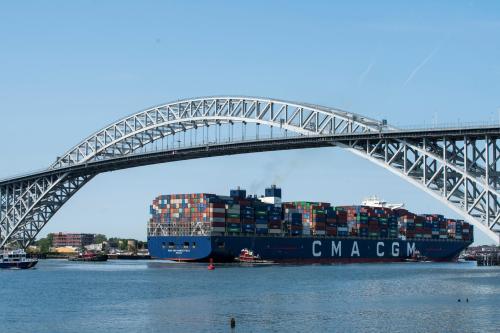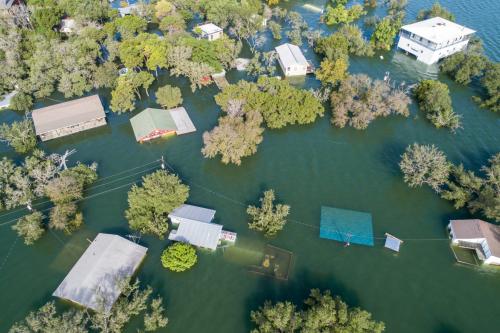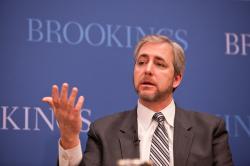For the nation’s infrastructure and built environment, 2021 felt like a year of extremes. Extreme weather events such as Hurricane Ida, western wildfires, and recently, the Kentucky tornados made the effects of climate change harder to ignore. Housing prices and rents rose precipitously, driven by strong demand, pandemic-related supply constraints, and policy choices. The digital divide persisted, separating children from school and workers from jobs.
But it was also a year of extreme change within policy circles. The landmark Infrastructure Investment and Jobs Act (IIJA) was a generational commitment from the federal government to respond to these challenges, and many cities and states stepped up to liberalize their zoning, build safer biking infrastructure, and create stronger pathways to infrastructure jobs.
As we get ready to start a new year, we asked Brookings Metro’s staff members and nonresident senior fellows what the most pressing built environment issues could be in 2022. Their responses demonstrate the significance of both the challenges as well as the opportunities to deliver change for people and the planet.
Putting water at the center of built environment’s transition
Dr. Newsha K. Ajami, Nonresident Senior Fellow
If we’re going to address climate concerns at scale in 2022, we need to modernize water infrastructure. Our water infrastructure system, while mighty, has some fatal flaws. It is a once-through and linear system, delivering clean water to our taps while treating wastewater and stormwater as nuisances to be captured and removed as quickly as possible. More than 70% of our water is brought in from long distances, purified, and treated to the highest drinkable quality—only to be then used outdoors or flushed down the toilet. Meanwhile, every day, new buildings, neighborhoods, and subdivisions emerge to tap into these same outdated systems.
We now have a once-in-a-lifetime opportunity to build a climate resilient and equitable water future. Infrastructure dollars need to be spent on solutions that can help us embrace a circular water economy, reuse water at various scales, and fit quality to its intended use: from homes (e.g., shower to toilet) to buildings (greywater reuse for outdoors irrigation) to neighborhoods (shared satellite reuse facilities and stormwater capture and reuse) to utility and regional scales. We can activate digitally fueled system efficiency by investing in soft infrastructure (data, IT, decision support tools) at every scale to enable a transition to a modern water governance structure.
Water policy must be at the heart of our environmental transition. And now with significant new resources, it’s an ideal time to modernize.
Mobile phone data can help planners, but can it be used responsibly?
Alex Berke, Nonresident Senior Fellow
We can expect to see a deluge of new plans and dollars to address climate change in 2022. An important question, then, is which investments best leverage this money?
Data is a critical tool in this pursuit, used to understand how people travel and to model the impacts of potential changes. Traditionally, data is sourced by government commuter and travel surveys, and datasets are freely shared as public goods. However, the frequency and reach of survey datasets now pale in comparison to data from mobile phones.
A multibillion dollar industry revolves around location data from mobile phones, mainly for use in the private sector. This data can also provide government transportation agencies a more comprehensive view than traditional surveys, with continuously collected data from a much larger sample population. A number of U.S. companies now buy mobile phone data in order to sell analytics services to transportation agencies.
While mobile phone data may be powerful in informing coming transformations to the built environment, there are questions about how to ethically manage these datasets. Mobile phone data presents new privacy risks, and the public are often not aware that they are being “surveyed.” Who will be responsible for ensuring data does not reveal sensitive information, such as where individuals travel? Who will ensure datasets represent different demographic groups without bias? Given these datasets are collected from the public and can benefit the public, should they serve as public goods, like survey data? If mobile phone data is going to be used to benefit the public through infrastructure investments and addressing climate change, then 2022 should be a year to find answers to these questions.
The most devastating storm is the one we don’t prepare for
Rushaine Goulbourne, Research Associate
The challenge to the built environment I foresee for 2022 and beyond is in our response to the threat of hurricanes. Each fall we get a tangible reminder of the physical, economic, and human costs inflicted by climate change, and some of the most destructive natural disasters to impact the United States in the past 20 years have been hurricanes.
Though the shock factor of deaths, destroyed homes, and ever increasing destruction wanes by the beginning of the new year, a new hurricane season is only six months away. Given this short time span, the decisions we make must be precise and well thought out to avoid recurring levels of destruction year after year.
Coming off the heels of the pandemic, job markets in many of the country’s coastal regions have suffered greatly, with workers laid off and businesses shutting down. In the coming year, coastal regions will be in rebuilding mode. Businesses are relying on either a less damaging hurricane season or prudent use of public funds to fortify infrastructure needed for day-to-day operations, such as power and water supply. For some businesses, a service disruption means shutting down.
The IIJA includes funds to protect against hurricane damage, which could be a lifeline for businesses in coastal areas. State and local governments must decide early how this money can be used to ensure the viability of their economies given an active 2022 hurricane season.
The federal government should move quickly to restore fair housing enforcement
Noah Kazis, Nonresident Senior Fellow
Housing discrimination and segregation are essential mechanisms in entrenching racial hierarchies in this country, driving inequalities in everything from household wealth and economic opportunity to educational and health outcomes. So, a place where I’d like to see serious urgency in 2022 is in the Department of Housing and Urban Development’s (HUD) rulemaking process for the Affirmatively Furthering Fair Housing policy (AFFH).
Since the passage of the 1968 Fair Housing Act, overt discrimination based on race has been illegal. But 50 years later, high levels of racial segregation persist. HUD spent almost the entirety of the Obama administration developing a set of regulations (AFFH) to create a new, formal framework to help states, cities, and public housing authorities proactively reduce barriers to racial integration, such as zoning that bans apartments in affluent white communities. But the Trump administration promptly tore down the AFFH’s regulations.
Now, HUD is restoring and revising the AFFH framework. The department’s previous strategy was too slow and dependent on bottom-up consensus-building for a polarized era of administrative U-turns. The Obama-era AFFH rules spurred a handful of cities to engage in new planning processes focused on fair housing, but HUD never made it to the point of enforcement—no city or state was forced to do anything in particular. The AFFH theory of change was measured in decades, but it only survived a little over a year.
States and cities across the country should meaningfully revising their policies and practices in 2024 before it’s too late. That means that by 2023, there must be not only a rule that offers a threat of consequences, but also enforcement actions to make that threat credible. Given the timelines built into the notice-and-comment rulemaking process, that leaves HUD very little time.
Building inclusive places requires building institutional capacity
Elizabeth Kneebone, Nonresident Senior Fellow
The tail end of 2021 has brought potentially game-changing levels of federal investment in the nation’s built environment. These federal investments have a role to play in remedying long-standing racial and economic inequities that have both shaped and been perpetuated by the nation’s built environment.
But to deliver on that potential, these investments must reach the people and communities who need them most—places often left behind by federal investments because they lack the capacity to attract or deploy these critical resources. Those capacity shortfalls can show up as gaps in local government staffing and systems and in a lack of civic infrastructure and nonprofit capacity—support systems that are critical to ensuring low-income communities and communities of color don’t lose out when federal dollars get allocated.
Bridging these gaps will take more—and more sustained—federal investments than what is currently earmarked in the infrastructure and social spending bills for technical assistance and capacity-building. The risk of exacerbating disparities in already struggling communities by failing to ensure they can access and deploy these resources makes addressing long-standing capacity gaps a pressing priority in 2022.
Achieving racial justice requires equitable land use practices—not just yard signs
Anika Singh Lemar, Nonresident Senior Fellow
Many have noted the incongruity of Black Lives Matter yard signs sharing space with anti-housing propaganda. This dissonance is not confined to NIMBY’s lawns. For example, in Connecticut, the Trust for Public Land spent $4 million, supplemented by $2 million in local bonding, to purchase 288 acres of land. The previous owner had spent two decades seeking local approvals for mixed-income housing, but the town of Simsbury fought the builder through litigation and appeals to the zoning board at every stage of the approval process.
Using legal and political opposition to block moderately priced housing are tactics echoed across the country in towns that benefit from proximity to a city but erect housing and zoning policies intended to ensure that their demographics differ wildly from that city. While some localities scrape funds together to purchase school supplies, others spend millions to “preserve” golf courses and corporate campuses as “open space” rather than allow the development of moderate and low-income housing.
Our built environment is the result of various racial injustices—including selective preservation of “open space” in disproportionately white towns—and it reflects those injustices back at us in the form of a massive racial wealth gap and differential access to parks, public education, and other public resources. We must lend substance to our commitments to racial justice, develop metrics by which we can measure success, and promise not just solidarity, but quantifiable improvements to people’s lives.
States must find a way to seize the broadband opportunity
Blair Levin, Nonresident Senior Fellow
For the first time, Congress has appropriated sufficient funds to address the nation’s baseline broadband challenge: deploying future-proof networks everywhere. The most pressing issue in the upcoming year is how to assure those funds are spent wisely to accomplish that goal.
That is far from assured. Congress chose to allocate the funds to the states rather than the Federal Communications Commission, the principal federal agency historically charged with that mission. Unlike with roads, bridges, water and sewer systems, and other infrastructure, no states have long-established departments experienced in spending large federal allocations for broadband.
States must now build capacity to spend between $50 billion and $100 billion for broadband networks, largely in unserved and underserved communities. This requires mapping, competitive grant-making, coordinating with other infrastructure projects (for “dig once” purposes), generating local government input on what is needed, and assuring the grantees meet their commitments, among other needs. To build this capacity requires a surge of state, local, and federal cooperation producing best practices that states can use to address these challenges.
The urgency to retrofit American suburbs
Robert Puentes, Nonresident Senior Fellow
For many years, the simple demarcations that divided “city” and “suburb” were clear. Cities were dense, diverse, and filled with jobs. Suburbs were single-family, white, rich, bedroom communities. Even if that overly simplistic depiction was not really true in the past, it certainly is not true now. Suburbs in the nation’s largest metropolitan areas are now home to more Black, Latino or Hispanic, and Asian American residents than cities. They are also home to most of the nation’s immigrants.
While the people have changed, the suburban built environment is slow to remake itself. Despite examples of strong downtowns, diverse neighborhoods, multigenerational housing, and expanded public transit in the suburbs, low density, auto-oriented development still dominates. It’s not from a lack of trying. The best laid plans to achieve sustainable and equitable suburban growth are too often repelled by strong voices driven by (at best) concerns over community character and (at worst) dog whistle racism. Not by accident, most Americans still live in racially segregated places.
Given their deleterious effects, one of the most pressing issues facing the built environment in 2022 is reversing these trends. There are no easy solutions, but it does require generating support for aggressive policies around zoning reform, parking reductions, and affordable housing production. Remaking suburbs will not happen overnight. It will require a new generation of government and business leaders who are willing to risk political and private capital. It will also demand a rethinking of obsolete, outdated suburban attitudes toward density, urbanity and diversity.
State should reimagine how they fund transportation
Gian Claudia Sciara, Nonresident Senior Fellow
The IIJA delivers long-needed federal funds for all modes of transportation and makes important 21st century investments, but it also ignores the growing dysfunction in U.S. transportation funding. To stave off Highway Trust Fund bankruptcy, the law leans on a yet another patch—worth $90 billion this time—from the U.S. General Fund instead of increasing gasoline taxes or introducing other forward-looking user fees.
Although federal transportation funding remains stuck in the 20th century, there’s no reason state funding must as well. States contribute over 70% of their own funds for transportation expenditures, and state legislators can make a number of moves that would reimagine revenue for the demands of 21st century mobility.
For example, states have long fretted that rising vehicle fuel-efficiency and adoption of electric vehicles (EVs) erode gas tax receipts—the largest revenue source (39% in fiscal year 2021) for state transportation funds. But many states could pilot new mileage-based road user fees, which would simultaneously address revenue needs and invite efficiency in private vehicle use through less driving. States that do not use vehicle registration fees for electric and hybrid vehicles could add them, ensuring EV drivers pay their fair share of costs to maintain roads and bridges. State legislatures could also enable and encourage regions and local governments to raise their own transportation revenues. Finally, where states have constitutional or statutory restrictions limiting transportation to road spending, lawmakers could revisit these restrictions to support a broader set of transportation modes and investments that enhance sustainable mobility.
Democracy depends on delivering housing affordability
Evan Siddall, Nonresident Senior Fellow
The next year’s most pressing issue in the built environment relates to the complicated interaction of the COVID-19 pandemic, climate change, low interest rates, uncertainty on housing prices, and the resulting increase in socioeconomic inequality. These factors are hurting housing affordability and creating a new landed gentry of homeowners who keep getting wealthier. Essential workers, nurses, teachers, and the people we take for granted to make our morning coffee—the backbone of our economy—can no longer afford to buy homes and are falling ever farther behind.
The pandemic-related urban exodus has also driven suburban housing prices higher, as have supply chain distractions and a skilled labor shortage. Monetary policy is aggravating the problem, since housing markets are highly rate-sensitive. Legacy fiscal policies and government-sponsored enterprises (Fannie Mae and Freddie Mac in the U.S., and my former employer, Canada Mortgage & Housing Co. in Canada) continue to add inflationary stimulus in the form of mortgage securitization and mortgage insurance.
If we are to preserve the integrity of our western liberal democratic system, we need to attend to housing affordability so that everyone can enjoy the safety and sense of belonging that a secure home represents.
Livable density in cities can mitigate climate change impacts and increase economic opportunity
Christopher Severen, Nonresident Senior Fellow
Mitigating the worst effects of climate change requires large reductions in carbon emissions. Cities can help; emissions are lower for urban dwellers than for others. However, as cities have become more expensive and congested, fewer people can access their benefitsfewer people can move or stay there. Aside from missing out on the many benefits of urban life, they also cannot access the lower carbon lifestyle that comes naturally in cities.
A solution can be found in using cities’ land and transportation infrastructure more efficiently. Neighborhoods—especially those near transit or urban centers—should add livable density. This will increase access to the benefits of being near a city without raising prices. And more efficient transportation infrastructure lets people get to jobs, activities, and each other without increasing emissions or congestion.
But cities need to approach densification and transportation infrastructure together. Los Angeles provides an illustrative example. Before building their new subway system, the city passed Proposition U, limiting density in much of the city. As the transit system grew, there was little response in the geography of economic activity. Complementary investments in land use and infrastructure are vital for getting the most out of our cities and sustaining future growth.
Cities must step up to the climate change challenge
Jan Whittington, Nonresident Senior Fellow
The Intergovernmental Panel on Climate Change is unsparing in its call for the elimination of net greenhouse gas (GHG) emissions, yet very few cities can claim that they are investing at a pace consistent with the goal of limiting the world to a 1.5-degree Celsius increase. Too often, cities take the easy route to climate action, promoting demonstration projects or championing the inherent features of projects that were already slated for development. Investment in climate-friendly infrastructure remains inadequate, siloed within individual sectors or dedicated to recovering from specific types of hazards. In the U.S., too few cities are using their financial capacity for meaningful multisectoral infrastructure investments that lead by example and high-powered incentives for developers and homeowners to transition at city scale.
An estimated 70% of GHG emissions are attributable to urban settlements through their reliance on energy sources such as coal, oil, and gas, and materials such as cement. Eliminating emissions from cities necessitates planning not only for cities, but for the infrastructure systems within cities: the energy sector, the building stock, the transportation system, and the processing of waste.
The urgency of this transition has been evident for some time. The damaging effects of the changing climate are already experienced by more than 70% of cities worldwide, driving up the cost of complacency. Cities are the engines of the world’s economies and home to a majority of the its population; we all need them to be effective in exercising climate action.
…


















Commentary
Around the halls: Built environment issues that could define 2022
December 21, 2021